外文翻译--股权结构与公司绩效 以印度为例
股权结构及其对公司绩效影响分析
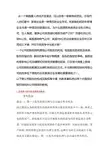
从一个侧面看人类经济发展史, 可以说是一部家族经营史。
在现代人的印象中, 家族企业是一种落后的企业形式, 用家族的规则来管理企业也是一种落后的管理方法。
为什么我国有些家族企业如三株公司、巨人集团、爱多公司其鼎盛时期即为破产之时? 而像杜邦公司、IBM公司、美国通用电气公司、美国3M公司这些家族企业百年沉浮而经久不衰, 并在市场竞争中长胜不败?一个公司的股权结构是指公司股东的构成, 包括股东的类型及各类股东持股比例, 股份的集中或分散程度、股东的稳定性等等。
股权结构是影响公司治理模式和绩效很重要的因素, 它在很大程度上影响公司控制权的配置及治理机制的运行方式。
不合理的股权结构导致公司的效率低下是制约这些家族企业发展的重要原因之一。
以下就公司股东的构成及股权集中度也就是量和质这两个方面探讨股权结构对公司绩效的影响。
1股权集中度对经营绩效的影响一、研究假设假设一:第一大股东持股比例与公司成长性负相关侵占假设认为控股股东的利益和外部小股东的利益并不一致,两者之间经常出现严重的利益冲突。
在缺乏外部监督或者外部股东类型多元化的情况下,控股股东可以以其他股东的利益为代价来追求自身利益。
控股股东侵害小股东的利益的手段多种多样,比如证券回购、资产转移、利用转移定价进行内部交易等。
这种行为对公司的成长不利。
因此本文提出假设1:第一大股东持股比例与公司成长性负相关。
假设二:对第一大股东的制衡度与公司成长性正相关对第一大股东的制衡度是指第二、三、四、五大股东所占股份比例之和占总股份的比例。
他们大多是机构投资者。
该变量可以在一定程度上衡量公司股东间的制衡机制,因为大的机构投资者可以通过影响董事会的选聘来影响董事会的构成。
Gilson(1990)研究发现,当企业业绩滑坡时,外部董事的比例随着机构投资者持股比例的增大而有所增加。
Shleifer与Vishny(1986)、Jensen(1993)等曾指出大的机构投资者有监督公司管理者的动因,形成控制机制之一。
股权结构与企业财务绩效
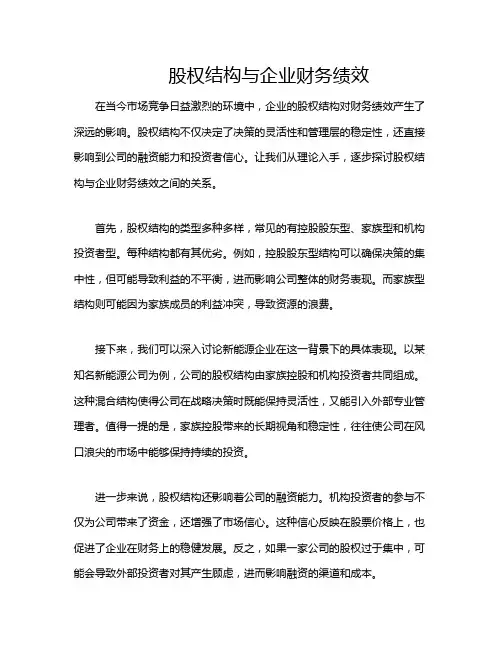
股权结构与企业财务绩效在当今市场竞争日益激烈的环境中,企业的股权结构对财务绩效产生了深远的影响。
股权结构不仅决定了决策的灵活性和管理层的稳定性,还直接影响到公司的融资能力和投资者信心。
让我们从理论入手,逐步探讨股权结构与企业财务绩效之间的关系。
首先,股权结构的类型多种多样,常见的有控股股东型、家族型和机构投资者型。
每种结构都有其优劣。
例如,控股股东型结构可以确保决策的集中性,但可能导致利益的不平衡,进而影响公司整体的财务表现。
而家族型结构则可能因为家族成员的利益冲突,导致资源的浪费。
接下来,我们可以深入讨论新能源企业在这一背景下的具体表现。
以某知名新能源公司为例,公司的股权结构由家族控股和机构投资者共同组成。
这种混合结构使得公司在战略决策时既能保持灵活性,又能引入外部专业管理者。
值得一提的是,家族控股带来的长期视角和稳定性,往往使公司在风口浪尖的市场中能够保持持续的投资。
进一步来说,股权结构还影响着公司的融资能力。
机构投资者的参与不仅为公司带来了资金,还增强了市场信心。
这种信心反映在股票价格上,也促进了企业在财务上的稳健发展。
反之,如果一家公司的股权过于集中,可能会导致外部投资者对其产生顾虑,进而影响融资的渠道和成本。
分析完股权结构对融资的影响后,我们再看看它如何影响企业的运营效率。
以这家新能源企业为例,机构投资者的参与使得公司在技术创新和市场开拓上更具活力。
相较于其他股权结构单一的公司,这家企业能迅速响应市场变化,及时调整战略,以确保其财务绩效的持续增长。
最后,总结一下股权结构与企业财务绩效之间的关系。
一个良好的股权结构能够为企业创造一个有利的发展环境,提升其整体的财务表现。
而新能源企业的成功案例则充分展示了这一点。
通过合理的股权安排,这家公司在竞争激烈的市场中脱颖而出,实现了可持续的发展。
总之,股权结构的设计和优化是企业发展中不可忽视的重要环节。
只有深入研究并适应市场变化,企业才能在复杂的经济环境中找到自己的立足之地,最终实现财务绩效的提升。
创业板上市公司股权结构特征及其与公司绩效关系
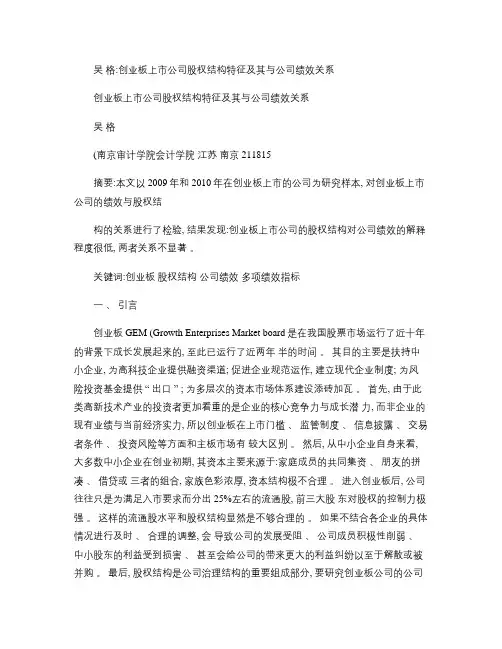
吴格:创业板上市公司股权结构特征及其与公司绩效关系创业板上市公司股权结构特征及其与公司绩效关系吴格(南京审计学院会计学院江苏南京 211815摘要:本文以 2009年和 2010年在创业板上市的公司为研究样本, 对创业板上市公司的绩效与股权结构的关系进行了检验, 结果发现:创业板上市公司的股权结构对公司绩效的解释程度很低, 两者关系不显著。
关键词:创业板股权结构公司绩效多项绩效指标一、引言创业板GEM (Growth Enterprises Market board是在我国股票市场运行了近十年的背景下成长发展起来的, 至此已运行了近两年半的时间。
其目的主要是扶持中小企业, 为高科技企业提供融资渠道; 促进企业规范运作, 建立现代企业制度; 为风险投资基金提供“ 出口” ; 为多层次的资本市场体系建设添砖加瓦。
首先, 由于此类高新技术产业的投资者更加看重的是企业的核心竞争力与成长潜力, 而非企业的现有业绩与当前经济实力, 所以创业板在上市门槛、监管制度、信息披露、交易者条件、投资风险等方面和主板市场有较大区别。
然后, 从中小企业自身来看, 大多数中小企业在创业初期, 其资本主要来源于:家庭成员的共同集资、朋友的拼凑、借贷或三者的组合, 家族色彩浓厚, 资本结构极不合理。
进入创业板后, 公司往往只是为满足入市要求而分出25%左右的流通股, 前三大股东对股权的控制力极强。
这样的流通股水平和股权结构显然是不够合理的。
如果不结合各企业的具体情况进行及时、合理的调整, 会导致公司的发展受阻、公司成员积极性削弱、中小股东的利益受到损害、甚至会给公司的带来更大的利益纠纷以至于解散或被并购。
最后, 股权结构是公司治理结构的重要组成部分, 要研究创业板公司的公司治理问题就需要从股权结构的特征分析入手, 研究公司股权结构的构成对业绩的影响, 为优化我国创业板上中小企业的公司治理提供参考。
由于创业板上市公司在主体资格、股本要求、董事、管理层和实际控制人等多方面与在主板市场上市的公司有很大区别, 相应地, 其股权结构特征与在主板市场上市的公司也有很多差异。
股权结构对公司绩效的影响
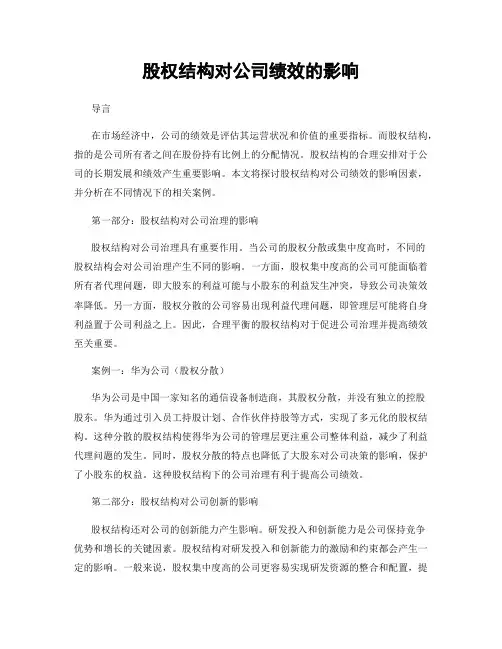
股权结构对公司绩效的影响导言在市场经济中,公司的绩效是评估其运营状况和价值的重要指标。
而股权结构,指的是公司所有者之间在股份持有比例上的分配情况。
股权结构的合理安排对于公司的长期发展和绩效产生重要影响。
本文将探讨股权结构对公司绩效的影响因素,并分析在不同情况下的相关案例。
第一部分:股权结构对公司治理的影响股权结构对公司治理具有重要作用。
当公司的股权分散或集中度高时,不同的股权结构会对公司治理产生不同的影响。
一方面,股权集中度高的公司可能面临着所有者代理问题,即大股东的利益可能与小股东的利益发生冲突,导致公司决策效率降低。
另一方面,股权分散的公司容易出现利益代理问题,即管理层可能将自身利益置于公司利益之上。
因此,合理平衡的股权结构对于促进公司治理并提高绩效至关重要。
案例一:华为公司(股权分散)华为公司是中国一家知名的通信设备制造商,其股权分散,并没有独立的控股股东。
华为通过引入员工持股计划、合作伙伴持股等方式,实现了多元化的股权结构。
这种分散的股权结构使得华为公司的管理层更注重公司整体利益,减少了利益代理问题的发生。
同时,股权分散的特点也降低了大股东对公司决策的影响,保护了小股东的权益。
这种股权结构下的公司治理有利于提高公司绩效。
第二部分:股权结构对公司创新的影响股权结构还对公司的创新能力产生影响。
研发投入和创新能力是公司保持竞争优势和增长的关键因素。
股权结构对研发投入和创新能力的激励和约束都会产生一定的影响。
一般来说,股权集中度高的公司更容易实现研发资源的整合和配置,提高研发投入和创新效率。
然而,研发投入程度过高也可能导致公司短期利润下降,进而影响股东利益。
案例二:特斯拉(股权集中)作为全球知名的电动汽车制造商,特斯拉一直以来都高度重视研发投入和创新能力。
特斯拉创始人埃隆·马斯克是公司最大的股东,其在公司决策中拥有相对更大的话语权。
这种股权集中的结构使得特斯拉在研发方面能够更加灵活和迅速响应市场需求,推动了公司的创新能力。
股权法中英对照
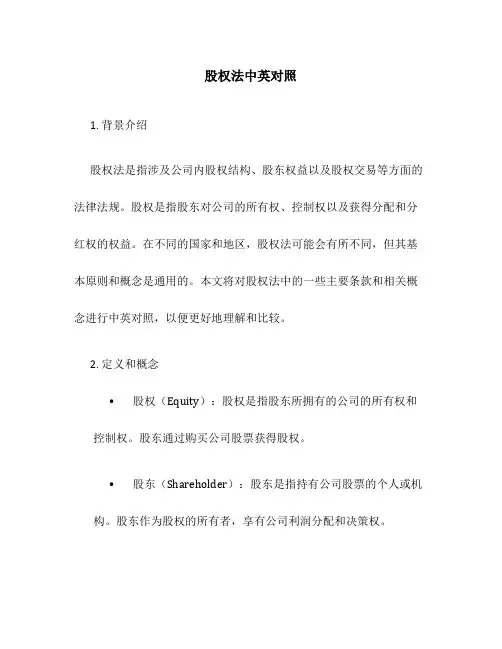
股权法中英对照1. 背景介绍股权法是指涉及公司内股权结构、股东权益以及股权交易等方面的法律法规。
股权是指股东对公司的所有权、控制权以及获得分配和分红权的权益。
在不同的国家和地区,股权法可能会有所不同,但其基本原则和概念是通用的。
本文将对股权法中的一些主要条款和相关概念进行中英对照,以便更好地理解和比较。
2. 定义和概念•股权(Equity):股权是指股东所拥有的公司的所有权和控制权。
股东通过购买公司股票获得股权。
•股东(Shareholder):股东是指持有公司股票的个人或机构。
股东作为股权的所有者,享有公司利润分配和决策权。
•股票(Stock):股票是公司发行给股东的所有权凭证。
持有股票意味着持有相应比例的股权。
•股权结构(Equity Structure):股权结构指公司内部股权分配和所有权关系的安排和组织。
•股东权益(Shareholder’s Equity):股东权益是指股东对公司所有资产和收益的权益。
股东权益包括股本、资本公积、未分配利润等。
3. 股权交易•股票交易(Stock Trading):股票交易是指股东之间买卖股票的行为。
股票交易有时也被称为股权交易。
•股票市场(Stock Market):股票市场是股票买卖的场所。
股票市场可以是交易所、场外市场或电子交易平台等。
•股权转让(Equity Transfer):股权转让是指股东将自己持有的股权转让给另一方的行为。
•股份转让(Share Transfer):股份转让是指股东将自己持有的公司特定股份转让给另一方的行为。
4. 股东权利和义务•股东权利(Shareholder’s Rights):股东权利是指股东作为股权的所有者所享有的权益。
股东权利包括参与公司经营决策、分配公司利润等。
•股东义务(Shareholder’s Obligations):股东义务是指股东作为股权的所有者所应承担的责任和义务。
股东义务包括遵守公司章程、保护公司利益等。
资本结构与绩效外文翻译
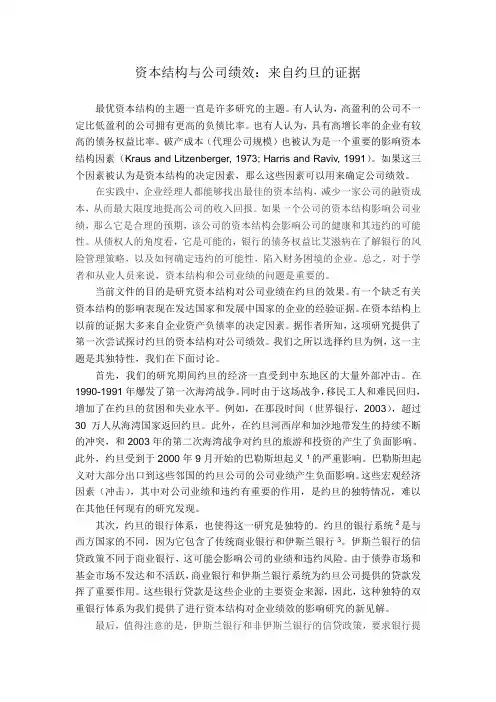
资本结构与公司绩效:来自约旦的证据最优资本结构的主题一直是许多研究的主题。
有人认为,高盈利的公司不一定比低盈利的公司拥有更高的负债比率。
也有人认为,具有高增长率的企业有较高的债务权益比率。
破产成本(代理公司规模)也被认为是一个重要的影响资本结构因素(Kraus and Litzenberger, 1973; Harris and Raviv, 1991)。
如果这三个因素被认为是资本结构的决定因素,那么这些因素可以用来确定公司绩效。
在实践中,企业经理人都能够找出最佳的资本结构,减少一家公司的融资成本,从而最大限度地提高公司的收入回报。
如果一个公司的资本结构影响公司业绩,那么它是合理的预期,该公司的资本结构会影响公司的健康和其违约的可能性。
从债权人的角度看,它是可能的,银行的债务权益比艾滋病在了解银行的风险管理策略,以及如何确定违约的可能性,陷入财务困境的企业。
总之,对于学者和从业人员来说,资本结构和公司业绩的问题是重要的。
当前文件的目的是研究资本结构对公司业绩在约旦的效果。
有一个缺乏有关资本结构的影响表现在发达国家和发展中国家的企业的经验证据。
在资本结构上以前的证据大多来自企业资产负债率的决定因素。
据作者所知,这项研究提供了第一次尝试探讨约旦的资本结构对公司绩效。
我们之所以选择约旦为例,这一主题是其独特性,我们在下面讨论。
首先,我们的研究期间约旦的经济一直受到中东地区的大量外部冲击。
在1990-1991年爆发了第一次海湾战争。
同时由于这场战争,移民工人和难民回归,增加了在约旦的贫困和失业水平。
例如,在那段时间(世界银行,2003),超过30万人从海湾国家返回约旦。
此外,在约旦河西岸和加沙地带发生的持续不断的冲突,和2003年的第二次海湾战争对约旦的旅游和投资的产生了负面影响。
此外,约旦受到于2000年9月开始的巴勒斯坦起义1的严重影响。
巴勒斯坦起义对大部分出口到这些邻国的约旦公司的公司业绩产生负面影响。
股权结构与公司并购绩效关联性探讨
股权结构与公司并购绩效关联性探讨一、引言股权结构作为公司治理的核心要素之一,对公司的运营决策、风险管理和绩效表现有着深远的影响。
公司并购作为企业扩张和资源整合的重要手段,同样对公司的长期发展和市场竞争力具有决定性的作用。
本文旨在探讨股权结构与公司并购绩效之间的关联性,分析不同股权结构对并购成功与否的影响,以及如何通过优化股权结构来提升并购绩效。
1.1 股权结构的定义与分类股权结构指的是公司股份的分配方式,它决定了公司控制权的归属和股东之间的权力平衡。
股权结构通常可以分为集中型和分散型两种基本形态。
集中型股权结构意味着公司的控制权集中在少数股东手中,而分散型股权结构则意味着公司的控制权较为分散,股东之间的权力较为平衡。
1.2 公司并购的概念与类型公司并购是指一家公司通过购买或合并另一家或多家公司的股份,以实现对目标公司的控制权。
并购可以分为横向并购、纵向并购和混合并购三种类型,每种类型都有其特定的目标和市场效应。
1.3 股权结构与公司并购绩效的关联性股权结构与公司并购绩效的关联性体现在多个层面。
一方面,股权结构影响着公司决策的效率和质量,进而影响并购决策的合理性;另一方面,股权结构还影响着公司对并购后整合的能力和资源配置的效率,从而影响并购的最终效果。
二、文献综述2.1 股权结构与公司治理股权结构与公司治理之间存在着密切的联系。
集中型股权结构可能导致“内部人控制”问题,使得公司决策偏向于少数大股东的利益,而忽视了小股东和其他利益相关者的利益。
分散型股权结构则可能引发“搭便车”问题,导致股东监督管理的积极性降低,影响公司治理的有效性。
2.2 股权结构与公司绩效股权结构对公司绩效的影响一直是学术界关注的焦点。
一些研究表明,集中型股权结构可能因为大股东的积极参与而提高公司绩效,而另一些研究则指出,过度集中的股权结构可能导致资源配置的效率降低,从而影响公司绩效。
2.3 公司并购绩效的影响因素公司并购绩效受多种因素影响,包括并购前的准备、并购过程中的谈判和交易结构设计、以及并购后的整合等。
股权结构对公司绩效的影响
股权结构对公司绩效的影响股权结构是指公司股份的持有者及其所持股份的分布情况。
公司绩效则是评估公司经营状况和发展潜力的重要指标。
那么,股权结构对公司绩效是否有影响呢?本文将就此问题进行探讨。
首先,股权结构对公司治理能力产生直接影响。
公司治理是指公司内部运作的一种机制,用于规范管理层和股东之间的权益关系,维护投资者权益。
当股权分散,公司治理风险相对较高,影响决策效率和合规性。
相反,当股权高度集中,存在着股东之间的权力过度集中,容易出现利益冲突和激励机制不完善的问题。
因此,一个合理的股权结构可以提高公司治理能力,从而对公司绩效产生积极影响。
其次,股权结构对公司的融资能力和成本也有一定影响。
当股权高度分散时,公司可能面临融资难度较大的挑战。
投资者对公司未来利润的期望可能会降低,从而提高融资成本。
此外,股权结构还与公司的成长能力和创新能力密切相关。
如果股权高度集中,那么公司决策过程会受到限制,也可能减缓公司创新和发展速度。
因此,一个适当的股权结构可以为公司提供更好的融资条件,进而促进公司的发展和创新,提高绩效表现。
另外,股权结构还与公司长期发展战略的稳定性有关。
股权分散的公司相对来说更容易受到外部干扰和股东利益冲突的影响,导致公司战略的频繁调整和不稳定性。
而当股权高度集中时,公司在运营过程中可能更加偏向于满足核心股东的利益,而忽视其他股东的权益。
因此,一个合理的股权结构可以帮助公司实施更稳定的长期战略,提高公司绩效的可持续发展性。
此外,股权结构还与公司的风险管理能力密切相关。
当股权高度分散时,公司可能面临流动性风险和管理风险增加的挑战。
股东之间的分散持股可能导致对公司决策的支持不足,同时也可能增加公司治理的复杂性。
相反,当股权集中时,公司的风险管理能力可能得到加强,同时也可能存在股东利益与公司整体风险承担之间的矛盾。
因此,公司需要在股权结构中找到权衡,平衡各方利益,提高风险管理能力,进而提高公司绩效。
综上所述,股权结构对公司绩效产生着重要的影响。
《股权结构对经营绩效的影响国内外文献综述3500字》
股权结构对经营绩效的影响国内外文献综述1 国外研究现状关于股权结构与企业绩效的研究最早出现在1932年伯利和米恩斯的著作《私有产权与现代企业》中,他们探讨了股权分散以及公司产权分离所引起的委托代理问题。
在此之后,学术界开始关注上市公司股权结构与公司绩效之间的关系。
目前,国外学者们对这一问题的研究成果较为丰富,且有不同的见解,主要分为正相关、负相关、不相关和U 型相关四类。
相关研究成果如下:(1)关于股权结构和经营绩效存在正相关关系的研究Berle和Means(1932)[1]在《私有产权与现代企业》中认为,当公司股权集中度处在一个范围之内时,能够有效改善公司的治理结构并提高公司的经营绩效。
Jensen和Meckling(1976)[2]认为公司股东分为内部、外部股东两类,当内部股东持股比例越高,背离价值的最大化成本越低,公司价值就越高。
Yu Cui和Yin Zang(2019)[3]以中国IT上市公司作为研究对象,得出了股权结构和公司绩效之间具有正相关关系的结论。
(2)关于股权结构和经营绩效存在负相关关系的研究Leech和Leahy(1991)[4]发现公司的股权集中度越高,对公司的交易利润率及净资产的增长越起到负面影响。
Fama和Jensen(1997)[5]认为股权集中度的增加会强化股东的控制权,其损害公司利益而为其谋取私人利益的可能增加。
Alexander Abramov和Alexander Radygin(2017)[6]采取计量经济学的方法对俄罗斯114家最大的公司进行研究,得出国家持股会对公司绩效产生负面影响的结论。
(3)关于股权结构和经营绩效存在不显著相关关系的研究Demsetz和Lehn(1985)[7]以1980年美国上市公司作为研究对象,以会计收益率作为衡量企业绩效的指标与股权集中度建立模型,根据实证结果分析得出会计收益率和股权集中度二者之间没有显著的相关关系。
Cheung,Wei(2006)[8]通过从股东调整持股比例的成本角度对公司股权结构与经营绩效的之间的关系研究发现,股权结构与公司经营绩效呈正相关关系。
《企业资本结构对经营绩效的影响研究国内外文献综述4000字》
企业资本结构对经营绩效的影响研究国内外文献综述(一)国外相关文献综述国外学者对于资本结构与公司价值关系的研究开始得较早,形成了较为成熟的理论体系。
20世纪50年代Franco Modigliani和Merton H. Miller(1958)提出了经典MM理论,在完美市场的假设条件下,资本结构与公司价值没有关联。
基于经典的MM理论,各学者通过放松完美市场的一些假设条件,又形成了有税的MM理论、权衡理论、融资偏好理论、代理成本理论等一系列资本结构理论,认为资本结构会对公司价值产生影响。
Modigliani和Miller在1963年提出了有税的MM理论,即在考虑税收的情况下,由于负债的抵税作用,企业价值会随着负债比例的提高而增加。
然而,有税的MM理论没有考虑到随着负债的增加,企业的财务风险也会增加,基于此,Robicheck和Myers(1966)又提出了破产成本理论,即企业价值会随着负债的增加而降低。
Kraus和Litzenberer(1973)在有税的MM理论和破产成本理论的基础之上提出了权衡理论,负债比率的提高既会带来税盾效应,也会增加破产成本,因此存在一个最优的负债比率使企业的价值达到最大。
随着不对称理论的发展,20世纪70年代初的学者对于资本结构的研究进入了新资本结构理论的阶段。
Majluf和Myers (1984)将MM理论中的假设条件进一步放开,在信息不对称的情况下考虑企业的交易成本,企业选择的融资渠道顺序是内部融资、债务融资、权益融资。
Jesen和Meckling(1976)则认为信息不对称会产生股权代理成本和债权代理成本,这两者随负债比率变化的方向是反向的,因此企业能够找到一个最优的负债比率权衡这两种代理成本,使企业价值达到最大。
不少学者通过实证研究证实了上述理论。
Dimitris Margaritis和Maria Psillaki(2009)以法国制造业企业为样本进行实证分析,认为杠杆率与公司价值呈正相关,同时不同行业和不同的集中度的公司代理成本不同、公司价值不同,股权更集中的家族企业的绩效优于非家族企业。
- 1、下载文档前请自行甄别文档内容的完整性,平台不提供额外的编辑、内容补充、找答案等附加服务。
- 2、"仅部分预览"的文档,不可在线预览部分如存在完整性等问题,可反馈申请退款(可完整预览的文档不适用该条件!)。
- 3、如文档侵犯您的权益,请联系客服反馈,我们会尽快为您处理(人工客服工作时间:9:00-18:30)。
中文4200字,2650单词,14800英文字符出处:Srivastava A. Ownership Structure and Corporate Performance: Evidence from India[J]. International Journal of Humanities & Social Science, 2011, 7(3):209–233.原文Ownership Structure and Corporate Performance: Evidence from IndiaAuthor: Aman SrivastavaAbstractOwnership structure of any company has been a serious agenda for corporate governance and that of performance of a firm. Thus, who owns the firm’s equity and how does ownership affect firm value has been a topic investigated by researchers for decades. Thus, the impact of ownership structure on firm performance has been widely tackled in various developed markets and more recently in emerging markets, but was less discussed before, in India in recent changing environment. This paper is a moderate attempt to address the relationship of ownership structure of the firm and its performance. It investigates whether the ownership type affects some key accounting and market performance indicators of listed firms. The 98 most actively listed companies on BSE 100 indices of Bombay Stock Exchange of India, which constitute the bulk of trading, were chosen to constitute the sample of the study as of end of 2009-10. The findings indicate the presence of highly concentrated ownership structure in the Indian market. The results of the regression analyses indicate that the dispersed ownership percentage influences certain dimensions of accounting performance indicators (i.e. ROA and ROE) but not stock market performance indicators (i.e. P/E and P/BV ratios), which indicate that there might be other factors (economic, political, contextual) affecting firms performance other than ownership structure. Keywords: Ownership structure, corporate performance, corporate governance, India1. IntroductionOwnership structure of any company has been a serious agenda for corporate governance and that of performance of a firm. Thus, who owns the firm’s equity and how does ownership affect firm value has been a topic investigated by researchers for decades. Thus, the impact of ownership structure on firm performance has been widely tackled in various developed markets and more recently in emerging markets, but was less discussed before, in India in recent changing environment. Though the modern organization emphasizes the divorce of management and ownership; in practice, the interests of group managing the company can differ from the interests of those that supply the capital to the firm. Corporate governance literature has devoted a great deal of attention to the ownership structure of corporations. Shareholders of publicly held corporations are so numerous and small that they are unable to effectively control the decisions of the management team, and thus cannot be assured that the management team represents their interests. Many solutions to this problem have been advanced, as stated previously i.e. the disciplining effect of the takeover market, the positive incentive effects of the management shareholding stake and the benefits of large monitoring shareholders. A different problem, however, arises in firms with large controlling shareholders. Since a large controlling shareholder has both the incentives and the power to control the management team's actions, management's misbehavior is a second order problem when such a large shareholder exists. Instead, the main problem becomes controlling the large shareholder's abuse of minority shareholders. In other words, holders of a majority of the voting shares in a corporation, through their ability to elect and control a majority of the directors and to determine the outcome of shareholders' votes on othermatters, have tremendous power to benefit themselves at the expense of minority shareholders. Thus, the type of owners as well as the distribution of ownership stakes will undoubtedly have an impact on the performance of firms. Most of the empirical literature studying the link between corporate governance and firm performance usually concentrates on a particular aspect of governance, such as board of directors, share holders’ activism, compensation, anti-takeover provisions, investor protection etc. This paper is a moderate attempt to examine the relationship of ownership structure and performance of firms in India.The rest of the paper is organized as follows: Section 2 discusses on the literature review, where both theoretical and empirical studies on previous works are looked into. It also incorporates the corporate governance mechanism in India. In section 3, the methodology of this study is considered. Empirical results and discussions are made in section 4, while section 5 concludes the study.2. Literature ReviewThe firm’s equity and how does ownership affect firm value has been a topic investigated by researchers for decades; however, most of the studies in this context are conducted outside of India. The study failed to document any relevant study on the topic in Indian context. Fama and Jensen (1983 a & b) addresses the agency problems and they explained that a major source of cost to shareholders is the separation of ownership and control in the modern corporation. Even in developed countries, these agency problems continue to be sources of large costs to shareholders1.Demstez and Lehn (1985) argued both that the optimal corporate ownership structure was firm specific, and that market competition would derive firms toward that optimum. Because ownership was endogenous to expected performance, they cautioned, any regression of profitability on ownership patterns should yield insignificant results. Morck. (1988) by taking percentage of shares held by the board of directors of the company as a measure of ownership concentration and holding both Tobin’s Q and accounting profit as performance measure of 500 Fortune companies and using piece-wise linear regression, found a positive relation between Tobin’s Q and board ownership ranging from 0% to 5%, a negative relation for board ownership ranging from 5% to 25%, and again a positive relation for the said ownership above 25%. It is argued that the separation of ownership from control for a corporate firm creates an agency problem that results in conflicts between shareholders and managers (Jensen and Meckling, 1976).The interests of other investors can generally be protected through contractual arrangements between the company and concerned stakeholders, leaving shareholders as the residual claimants whose interests can adequately be protected only through the institutions of corporate governance (Shleifer and Vishny, 1997). Loderer and Martin (1997) took shareholding by the insiders (i.e., director’s ownership) as a measure of ownership. Taking the said measure as endogenous variable and Tobin’s Q as performance measure, they found (through simultaneous equation model) that ownership does not predict performance, but performance is a negative predictor of ownership. Steen Thomsen and Torben Pedersen (1997) examine the impact of ownership structure on company economic performance in the largest companies from 12 European nations. According to their findings the positive marginal effect of ownership ties to financial institutions is stronger in the market-based British system than in continental Europe. Cho (1998) found that firm performance affects ownership structure (signifying percentage of shares held by directors), but not vice versa. Jürgen Weigand (2000) documented that (1) the presence of large shareholders does not necessarily enhance profitability, and (2) the high degree of ownership concentrationseems to be a sub-optimal choice for many of the tightly held German corporations. Their results also imply ownership concentration to affect profitability significantly negatively.Their empirical evidence suggests that representation of owners on the board of executive directors does not make a difference. Yoshiro Miwa and Mark Ramseyer (2001) stated with a sample of 637 Japanese firms and confirmed the equilibrium mechanism behind Demstez-Lehn. Demsetz and Villalonga (2001) investigated the relation between the ownership structure and the performance (average Tobin’s Q for five years-1976-80) of the corporations if ownership is made multidimensional and also treated it as an endogenous variable. By using Ordinary Least Squares (OLS) and Two-stage Least Squares (2 SLS) regression model, they found no significant systematic relation between the ownership structure and firm performance. Demsetz and Villalonga (2001), examined the relationship between ownership structure and firm performance of Australian listed companies. Her OLS results suggest that ownership of shares by the top management is significant in explaining the performance measured by accounting rate of return, but not significant ifperformance is measured by Tobin’s Q. However, when ownership is treated as endogenous, the same is not dependent upon any of the performance measures. Lins (2002) investigates whether management ownership structures and large non-management block holders are related to firm value across a sample of 1433 firms from 18 emerging markets .He finds that large non-management control rights block holdings (having more control rights) are positively related to firm value measured by Tobin’s Q. Michael L Lemmon and Karl V Lins (2003) use a sample of 800 firms in eight East Asian countries to study the effect of ownership structure on value during the region’s financial crisis.The crisis negatively impacted firm’s investment opportunities, raising the incentives of controlling shareholders to expropriate minority investors. The evidence is consistent with the view that ownership structure plays an important role in determining whether insiders expropriate minority shareholders. Using a sample of 144 Israeli firms, Beni Lauterbach and Efrat Tolkowsky (2004) find that Tobin's Q is maximized when control group vote reaches 67%. This evidence is strong when ownership structure is treated as exogenous and weak when it is considered endogenous. Christoph Kaserer and Benjamin Moldenhauer (2005) address the question whether there is any empirical relationship between corporate performance and insider ownership. Using a data set of 245 Germen firms for the year 2003 they find evidence for a positive and significant relationship between corporate performance, as measured by stock price performance as well as by Tobin’s Q, and insider ownership. Kapopoulos and Lazaretou (2007) tried the model of Demsetz and Villalonga (2001) for 175 Greek firms for the year 2000 and found that higher firm profitability requires less diffused ownership structure He also provides evidence that large non management block holders can mitigate the valuation discounts associated with the expected agency problem.3. Data and MethodologyThe study aims to explore the disciplinary effect of the market in a context with concentrated ownership structure and weak investor protection. The paper aims to explore if there are dominant certain types of owners of actively listed and traded companies on Indian Stock Exchanges. Further, it investigates whether the ownership type affects some key accounting and market performance indicators of listed firms. It shows that there might be other reasons that have affected the performance of the listed companies of BSE 100, other than ownership structure.The data set consists of detailed trading and financial information and indicators about the 98most actively traded BSE 100 listed companies on the Bombay Stock Exchange of India (BSE) during 2009-2010. The ninety eight companies cover a broad spectrum of sectors or industries totaling 18, which are: Finance, Oil & Gas, Information Technology, Metal, Metal Products & Mining, Capital Goods, FMCG, Transport Equipments, Power, Housing Related, Healthcare, Telecom, Diversified, Chemical & Petrochemical, Miscellaneous, Media & Publishing, Transport Services, Tourism and Agriculture. The details and proportion of these sectors in BSE 100 is given in table 1.The main financial indicators obtained from the companies financial statements included Total Revenues or Turnover, Gross Profit, Net Income or Earnings After Taxes, Current Assets, Fixed Assets, Long Term Debt and Shareholders Equity. Finally, the third subset consists of companies’ stock performance indicators obtained from CMIE PROWESS database including value traded, volume traded, number of transactions, market capitalization, market price as well as some calculated ratios using both CMIE PROWESS database as well as items reported in financial statements of sample companies such as debt to equity ratio, return on equity, return on assets, price earnings ratio and price to book value. The empirical investigation is conducted using known Ordinary Least Square Estimation methodology using both Return on Equity (ROE) and Return on Investment (ROI) variables - representing accounting performance measures, and Price-Earning Ratio (P/E) and Price to Book Value (P/BV) –representing stock market performance measures; separately as dependent variables. The following formula was used for modeling:Yij = α + xff, j + xde,j + xdph,j + xfp,j + xnpi,j + xnpni,j + ε (i)Where ε ~ ND (0, σ2)Yij : i corresponds to ROE, ROI, P/E or P/B for company j (j=1...98)xff, j : represents the percentage of free float in company j capital structure,xde,j : represents the debt to equity ratio for company j,xdph,j and xfp,j : represents the domestic promoter and foreign promoter holding in the companyxnpi,j and xnpni,j : represents non promoter institutional and non promoter non institutional holding of the company.The independent variables are represented by the percentage of Free Floated shares (FF), Debt to Equity ratio (D/E) and four variables representing promoters and non promoters stake representing the ownership structure in sampled companies, namely; Tables (2) and (3), (4) and (5) in the appendix summarize the regression analysis.4. Results and analysisThe sampled companies of BSE 100 were analyzed on the basis of their free floats and the findings are given below in table 2. Table 2 clearly depict that majority of the sampled companies have less than 75% of the free float. Even 13% companies have a free float of less than 25%. Only 13% of the companies have a free float of greater than 75%. Table three gives the details about the ownership structure of the sampled firms. Data clearly depicts that the stake of Indian promoters I the sampled company varies from 0% to 99% with a average holding of 41%. That means on an average the sampled companies are dominated by Indian promoter’s holdings. While the average foreign promoters holding is just 7.51%. That clearly confirms the belief that the Indian companies are dominated by families and promoter’s stakes. Data related with debt equity profile of sampled companies is givenThe results clearly indicates that majority of the sampled companies are in first category of 0-2 which clearly depicts that the majority of the sampled companies are not highly levered.Performance measures in the paper are represented by two sets of variables accounting measures are ROA and ROE while the market measures are P/E and P/BV ratio. Table five depicts that average ROE, ROA, P/E and P/BV values are 17.36%, 12.77%, 34.8 and 3.8 respectively.The results of OLS regression analysis are given in table 6 below. The empirical results reflect at 5% level of significance the ownership characteristic does not reflect any relationship with either accounting performance measures ROA and ROE or show any significant relationship between ownership structure and stock market indicators P/E and P/BV ratios, as shown in Table (6) below. But at 10% level of significance all sampled variables shows significant relationship with ROA, ROE, P/E and P/BV for performance of any company. Insert table (6) about here5. Findings and ConclusionThe significance of ownership characteristics and accounting performance measures i.e. ROA and ROE could be explained by the fact that the fundamental evaluation of companies, measured by, its financial indicators such as (ROA and ROE) are the most important factors used by investors in India to assess company’s performance. In India, althou gh earlier investors have culturally placed more emphasis on accounting performance measures, not stock market indicators, due to the inactivity and stagnation of the stock market for a long period (till early 1990’s). Furthermore, Indian investors always favored payment of dividends rather than stock price appreciation, due to inactivity of market. Accordingly, the dividends yield paid by Indian companies are always very high (10%-13%) compared to other emerging and developed markets (3%-5%). Thus the author did not consider dividend yield in the stock market indicators since it will be a distorted measure since issuers in India always pay a high dividends yield, sometimes, irrespective of earnings, since they are valued by investors according to dividends not price appreciation. Furthermore, the type of ownership had an insignificant impact on stock market performance measures, which might imply that the stock performance was mainly affected by economic and market conditions rather than ownership concentration. Furthermore, the results could be related to the market inefficiency of the Indian stock market, given its small and thin characteristics, as well as the lack of prompt disclosure by listed companies, even the active ones, at the Indian stock market. Stock prices therefore may not appropriately reflect the costs and benefits of diversification as shown.References[1]Beni Lauterbach, and Efrat Tolkowsky, 2004, “Market Value Maximizing Ownership Structure when Investor Protection is Weak”, Discussion Paper No. 8-200[2]Cho M H (1998), “Ownership Structure, Investment, and the Corporate Value: An Empirical Analysis”,Journal of Financial Economics, Vol. 47, No. 1, pp. 103-121.[3]Demsetz H and Lehn K (1985), “The Structure of Corporate Ownership: Causes and Consequences”,Journal of Political Economy, Vol. 93, No. 6, pp. 1155-1177[4]Demsetz H and Villalonga B (2001), “Ownership Structure and Corporate Performance”, Journal of Corporate Finance, V ol. 7, No. 3, pp. 209-233.[5]Erik Lehmann en Jurgen Weigand, Does the governed corporation perform better Governance structures and corporate performance in Germany, European Finance Review, 2000, no. 4, p. 157–195.[6] Fama, E and Jensen, M, 1983a, 1983b. Separation of ownership and control, Journal ofLaw &Economics 26, 301-325 and 327-349.[7]Jensen, M and Meckling, W, 1976. Theory of the firm: managerial behavior, agency costs, and ownership structure. Journal of Financial Economics 3, 305-360.[8]Kapopoulas P and Lazaretou S (2007), “Corporate Ownership Structure and Firm Performance:Evidence from Greek Firms”, Corporate Governance: An International Review,V ol. 15, No. 2, pp. 144-158.[9]Kaserer Christoph, and Benjamin Moldenhauer, 2005, “Insider Ownership and Corporate Performance -Evidence from Germany”, Working Paper”, Center for Entrepreneurial and Financial Studies (CEFS) and Department for Financial Management and Capital Market[10]Lins, K, 2000, Equity Ownership and Firm Value in Emerging Markets, Working paper, University of Utah.[11]Loderer C and Martin K (1997), “Executive Stock Ownership and Performance Tracking Faint Traces”,Journal of Financial Economics, V ol. 45, No. 2, pp. 595-612.[12]Michael L Lemmon, and Karl V Lins, 2003, “Ownership Structure, Corpora te Governance and Firm Value: Evidence from the East Asian Financial Crisis” The Journal of Finance, Vol LVIII No. 4, August 2004[13]Miwa Yoshiro, and Mark Ramseyer, 2001, “Does ownership matter?” Discussion Paper, University of Tokyo[14]Morck, R, Shleifer, A, and Vishny, R, 1988. Management Ownership and Market Valuation: An Empirical Analysis, Journal of Financial Economic 20, 293-315.[15]Pedersen,T and Thompson, S, 1997, European Patterns of Corporate Ownership: A twelve country study, Journal of International Business Studies, 759-778[16]Shleifer, A and Vishny, R, 1997. A survey of corporate governance. Journal of Finance 52, 737-783.译文股权结构与公司绩效: 以印度为例资料来源: 人文和社会科学国际性杂志作者: Monir Zaman摘要任何一家公司的股权结构已经成为公司监管与公司绩效的重要事项。
